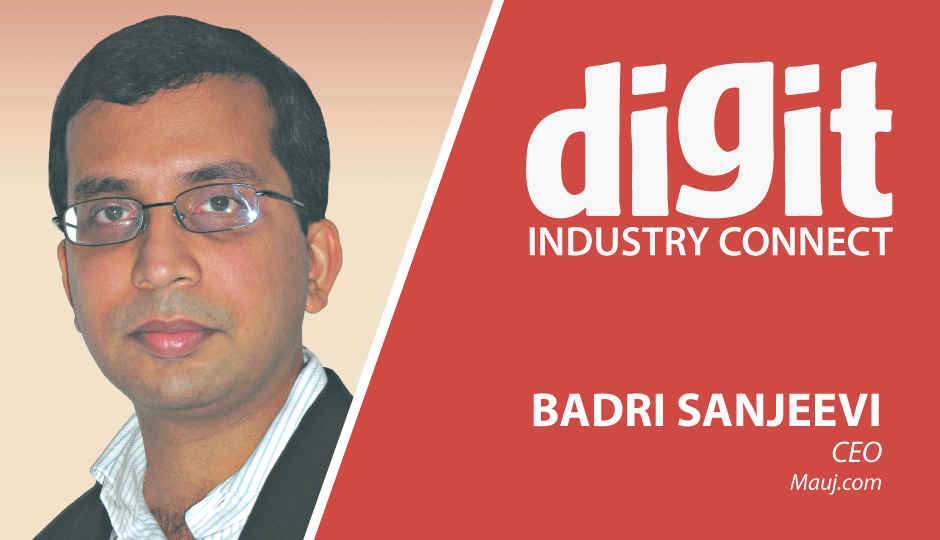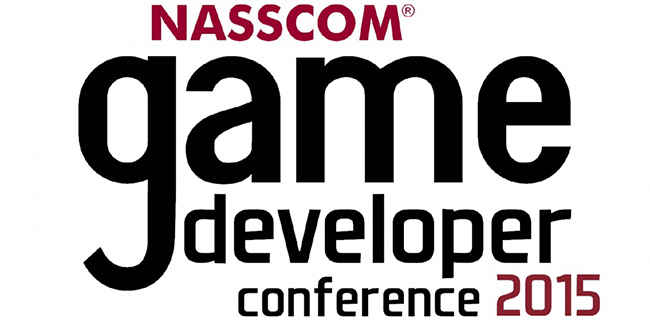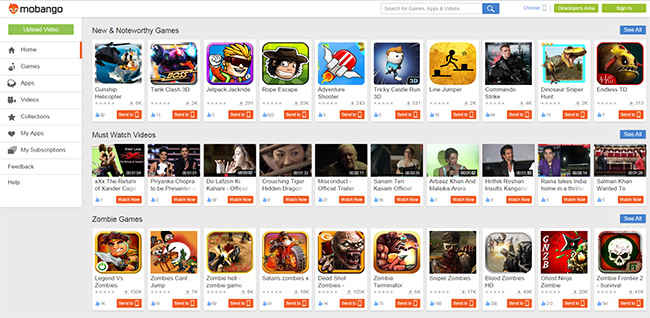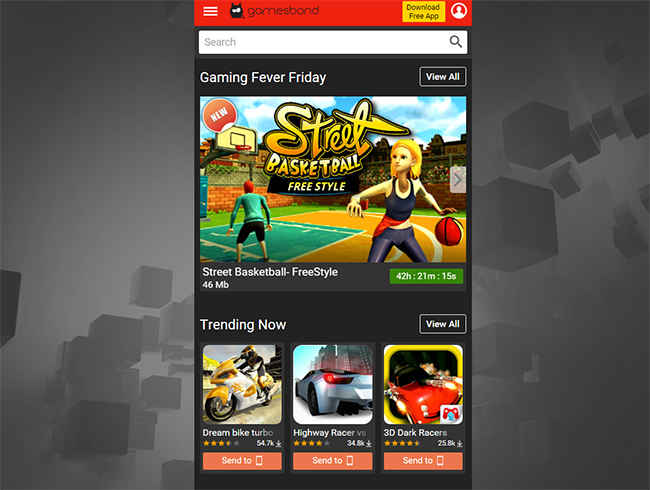Curated app stores are here to stay
We sit down with Co-founder and CEO of Mauj Mobile to learn how their app stores cater to the Indian audience

We got a pretty good insight into the Indian app-store scenario and the challenges they face after a sit-down with Mr. Badri Sanjeevi, CEO Mauj.com
 Survey
SurveyDigit: You have 3 properties Mobango, Games Bond and AppyStore. How are your platforms different from existing ones like Amazon’s AppStore, SlideME and GetJar?
Badri: To be very honest I don’t know if GetJar and SlideME are still alive. GetJar shut down and was sold to a Chinese company, I don’t know if they still operate. Haven’t seen that in a couple of years now. SlideME also I am not sure, maybe they do operate. I have to understand what that is. Let’s step back a little and look at Mauj Mobile. It’s a company that operates in two verticals, one is gaming and the other is kid’s edutainment. Another objective for us is to offer highly segmented content which have been curated. And the segments that we look at are very large with very large underlying market place. Today, if a user wants content they predominantly go to Google Play and YouTube, and we know that these platforms are pretty inefficient when it comes to offering highly curated content. What I mean by curated is, for example, if you go to AppyStore it will show content only for children below the age of eight. We have done a lot of work with teachers and experts for understanding what are the major developmental areas and milestones for children. You will find that the content is absolutely right for the child and the parent. If you go to our app in Google Play you will see that the feedback and rating from parents is exactly what we hoped to see. Parents find this as a great resource for their children and they also find that the app engagement is very high because it’s solving the problem for the end user. Similarly, on gaming what we are building and hoping to receive the whole 150 million gamers who are in India. We want to provide the gamers with an amazing gaming experience. Not throw at them 200,000 apps that Google Play may have, but throw at them a set of curated apps, across the most popular categories and each game is a good game with levels, depths and proper curation.
Digit: Why make Gamesbond, a new platform for premium games, and why not incorporate premium games into the existing platform – Mobango?
Badri: It is happening already happening in many ways.
Digit: Often there’s a certain stigma attached to third-party App stores. I’m not pointing the finger at your app store but there is the general view that third party app stores are where those apps land which don’t make the cut on native stores. How do you respond to that?
Badri: No, I think that’s not right. In terms of numbers there is no stigma. What I am saying is if you look at the numbers, we think that three billion game downloads happen in India in a year. And roughly half is delivered by Google Play and the other half is delivered by everything else so there is no stigma. Who are the biggest people in the other half? It’s Opera AppStore, UC browsers AppStore and Mobango AppStore which are all alternate app stores. If you go and talk to 10-15 gamers like we do every week with 5-6 gamers, you would find out that people are extremely comfortable going wherever they need to go to discover the content. There is no stigma, they know and understand how to download an APK, and know how to discern a good product from a bad product. So the customer is more sophisticated. So the stigma thing is not right.
For example, could you say at any given time there is stigma in watching a video in HotStar because it’s not on YouTube? Or is there stigma in watching something on Spuul or Hungama and not on YouTube. It was never the case, so why is there stigma in an executable file and not on a mpeg video, it is all what we have built up in our minds as analysts. So there was never a stigma in watching a video from wherever, also today people have started watching video on Snapchat and Facebook. So seeing as what Snapchat is based on, I think those are just misconceptions and the numbers don’t reflect on what is ascertained to have stigma. If I understand the Indian gamers and Indian parents’ mentality, then there might be half a dozen categories that are critically important to make an amazing AppStore or content store. So I just need to work hard on them and we can do very good job on them because we are focussing on those verticals, just like Myntra can do an amazing job in apparels then let’s say Amazon may not be to do. It’s exactly the same thing we can do like Myntra’s job in apparels that horizontals cannot do.
Digit: Despite making it easy to accept payments, do Indian customers pay? Because we’ve been talking to developers for quite a while now and the general consensus about this region is that people want free stuff, and most of the revenue is generated by serving ads. So how do you see a paid platform faring under such circumstances?
Badri: Yes, the Indian customer pays a lot of money. No developer makes much money nonetheless. So today if you look at a typical app, we are not having too many apps on Google Play, but whatever apps we are seeing, the average revenue of per install of Google Play on an average game is probably less than 50 cents. So that’s why there is a mad race on Google Play to get the most number of downloads, because the revenue on downloads is ridiculously low. 50 cents happens to be on the higher side, when you look at apps with the most number of downloads it’s probably around 15 – 10 cents, if they are lucky. So it’s terribly bad and on Google Play the payment mechanism has not really worked well, so in fact Google is also doing operator billing, which you know already. So to that extent operator billing is just a wallet and don’t think of it more than that. And if tomorrow, Paytm scales we might use Paytm or other service like FreeCharge if they scale. Maybe one day companies like Flipkart might realise that they have got about 100 million shoppers with credit cards on file and decide to open up a Google like API where they will make one-step transactions, then we will use Flipkart’s API or the payment ecosystem in India will undergo change where credit card transactions below 100 rupees wouldn’t need a 2-factor authentication and we could simply start using credit cards and the consumer doesn’t have to jump through 3 hoops while shopping. The payment ecosystem is evolving and we will try everything. Today it happens at the operator level within India since we have the largest wallet user base in India with 900 million people having wallets.
Digit: How do you make your platform more appealing to developers as well as users?
Badri: Modernization, discovery and distribution. But we aren’t only on gaming, try video, for example, let’s take one video player and call it Rajshri entertainments. Let’s take the example of Rajshri channel for YouTube which is run by Rajat. He is the number 5 YouTuber and number 10 YouTube channel in India. But Rajat doesn’t say YouTube is my sole game, Rajat distributes his content across 150 different stores around the world. So it’s actually on the owner of the content to go out there once he’s made a piece of content like his videos. The life of a video is incredibly short, maybe a month. And the life of a game is very short, maybe 6 months. But the effort in making the game and getting it out there through distribution channels is pretty dramatic. For example, on Google Play now, you will see five Chhota Bheem games right now on the homepage. Check after 6 months and none of them would be there. So these 6 months are all the developer has. How does he make the most money out of his content? The answer is blindingly obvious. And movies and videos have done this for as long as we can remember. Even the JAVA developers of the games till 2011-12 put their content on OVI, GetJar, SlideME and everything else. Because they understood that every channel mattered. And I think that other platforms like ours are just coming to scale now. The reason is our ecosystem is just three years old and you know that the Nokia ecosystem lived for about 25 years. So we are too young and I think it’s only a matter of time before developers say, “Today I uploaded on Google Play, and now let’s upload on 1,2,3,4 platforms … that’s it. So developers will come to us as long as we create many success stories. And we are working on creating those success stories. I will give an example of those success stories, UCBrowser were one of those amazing success stories and we have spoken about it in our PR releases. We had delivered about 20 million downloads. We have done success stories with game developers called HeroCraft for whom we have delivered 10-15 million downloads. For another video app called VidMate, we had delivered about 5 million downloads.
Digit: We heard, you’d started a new initiative at NASSCOM GDC to attract gamers. How is that program coming along?
Badri: We were at the NASSCOM GDC this year working with developers there creating success stories saying, “Hey listen, you can make money from us which is outside of Google Play”. And three developers took anywhere from Rs. 2 lakhs to `4 lakhs in the developers’ conference. The money is not that much, I am not cutting them a cheque of 2 crores, it’s still 2-4 lakhs which they didn’t have. This might have been the money they would have made from Google Play or maybe even a little bit less and that’s ok. After the launch of GamesBond we made a big splash at GDC (Game Developer Conference), we were all over the place. We gave out 6 awards this year and we sponsored both NASSCOM’s and our own awards. So we actually gave out most of the monetization to game developers and that’s what we are working on, convincing developers that we are an emerging platform and we are an interesting site that’s not to be ignored.

Digit: How do your platforms tackle piracy? There are hundreds of different blogs that put up nulled versions of paid apps and if you start having exclusive apps on your store, piracy becomes a huge concern.
Badri: Let it come. We are not bothered about that, actually from a developer's perspective piracy doesn’t matter to them because it's not the same as video piracy. And I will explain that to you. If you take a video file and you put it on Mobango and – let’s just say that for a minute we are a bad company and I make money from that video – the developer doesn’t even know his video has been distributed.
But the game file is an executable file, which means within the file there are trackers, cookies and codes, and Google tells you where the file came from. You just tell Google Analytics you are a developer and getting about 100,000 downloads from nine game sites and Mobango is one of them. I don’t remember giving my games to them and it takes one minute for the legal team to send us a notice. So the trackability of the executable files is so much high, that piracy inherently doesn’t exist. So for example we know that our own group company Shaadi.com's app is on the 9 apps site and we didn’t upload it and we know the metrics from the site, it may irritate us a little bit, but we are saying it whatever we are getting publicity and all. But lets just say tomorrow we find out that 9apps or Mobango doesn’t give good quality customers to Shaadi.com. Let’s just say 9apps users are coming on the app and messing up with the app where people are looking for serious matchmaking, I will ask 9apps and Mobango to take it down as they are giving me bad traffic. And if they are giving me good traffic, I will say let it come, its my app and I know exactly what it is. And if both sites are giving me good volume of traffic then I might go out and make sure that they have the latest build of my app. So you see it can work both ways. So ultimately trackability makes the video games and apps. So we know the feel of piracy of the apps where in videos we cannot.
Digit: So you’re not worried about the cracked apps which just null your tracking mechanism but worry about the ones which are actually trackable.
Badri: You can’t really remove a code from within an APK, without destroying the APK, it’s very difficult.
Digit: But you can find 100s of sites(including this one) giving you that.
Badri: But those codes are inside the core APK, not in the APK wrapper and most APKs are obfuscated, you can’t even read their code and you can’t reverse the obfuscation and you can’t tinker with the APK.
Digit: By this logic these cracked apps shouldn’t exist at all.
Badri: But they do. Our own app Shaadi.com exists on 9apps and we can see it. So trackability is still there. But you are saying hackers remove this trackability. I am no. I don’t know if you consider 9apps an app store or not. But let's consider it’s an app store. So these tracking libraries are not on the wrapper, but in the core APK.
Digit: So these are for natively coded apps. So let’s just say someone comes out with an HTML5 app. These can easily be opened – just right click and open it in Winrar – and you see all the files inside it. Also, there are numerous tools available to decompile apk files to access the core elements you talked about. dex2jar seems to be the most popular one and there are plenty of tutorials for people to use these tools. And removing tracking code snippets becomes just as simple. What can be done in this case?
Badri: If you say HTML5 game files then sure you can distribute the front end of the app in any app store, but the back end is at the server side, where its running. The backend is the server, no developer puts a their backend code in the front end HTML file. Actually a front end HTML file is a bunch of javascripts and we can track it back to the server. All HTML5 apps are server led, its not even in the front end led. Actually, just casual games are front-end led, but most good games are server led, you need media assets to be downloaded. Let’s just say the initial game download is just 100 MB and the rest 300 MB of assets comes from a server. So I know every download that happens. So the app ecosystem is solid that way.
Digit: When asked about what Mauj Mobile's platforms were doing to combat piracy, you offered the response that piracy is very difficult because Google's core libraries had tracking APIs built in. And that even if pirates manage to do anything, the app would still have to connect to the official server to work.
My contention is that this is not always the case. It is a common scenario to find apps that have been cracked / nulled. And it's not just the little guys, even the big guys lose revenue because of pirated games. And not only is it possible to nullify the tracking libraries within Apps but those with malicious intent have even managed to get their hands on the server files and host their own private servers which have turned out to be popular. Such is the case of Clash of Clans which has plenty of private servers which operate on a donation revenue model. Now for a big company like SUPERCELL which has a huge user base and an ARPU is $1.31, this might not be worth looking into. But let's say if a small developer launches an app on your platform, then what kind of legal mechanism(s) do you have in place to combat piracy?
Badri: Let me give you an example, YouTube has a lot of bollywood content that is not necessarily uploaded by the content owner. The video shall be on YouTube till the time the content owner brings it to the notice of YouTube that he/she owns that particular video. The same goes with the games on our platform. There are internal checks from our end for some of the most popular games that have high downloads where we personally check with the game developer if he/she has indeed uploaded the game. But it is a marketplace and not all games can be screened with developers to check if they indeed own the rights to the game.
Mithun Mohandas
Mithun Mohandas is an Indian technology journalist with 14 years of experience covering consumer technology. He is currently employed at Digit in the capacity of a Managing Editor. Mithun has a background in Computer Engineering and was an active member of the IEEE during his college days. He has a penchant for digging deep into unravelling what makes a device tick. If there's a transistor in it, Mithun's probably going to rip it apart till he finds it. At Digit, he covers processors, graphics cards, storage media, displays and networking devices aside from anything developer related. As an avid PC gamer, he prefers RTS and FPS titles, and can be quite competitive in a race to the finish line. He only gets consoles for the exclusives. He can be seen playing Valorant, World of Tanks, HITMAN and the occasional Age of Empires or being the voice behind hundreds of Digit videos. View Full Profile

